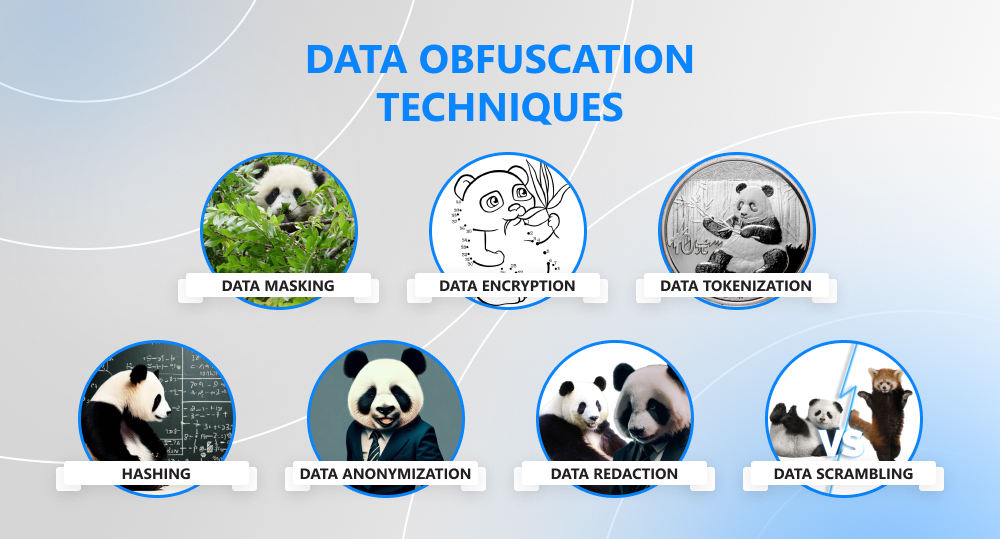Comparing data masking vs encryption will help you understand the key differences between these data obfuscation methods. They are used to protect sensitive information that is a daily target of hackers. Businesses lost $4.35 million in 2022 due to data breaches. Delving into the nuances of data masking and encryption will let you choose the best data obfuscation technique and hide your records.
Read our article and find a comprehensive data security solution that aligns with regulatory requirements and safeguards against potential threats.
written by:
Maxim Butov
Software Architect
Comparing data masking vs encryption will help you understand the key differences between these data obfuscation methods. They are used to protect sensitive information that is a daily target of hackers. Businesses lost $4.35 million in 2022 due to data breaches. Delving into the nuances of data masking and encryption will let you choose the best data obfuscation technique and hide your records. Read our article and find a comprehensive data security solution that aligns with regulatory requirements and safeguards against potential threats.
Contents
What Is Data Obfuscation?
Data obfuskation is a method used to protect sensitive information by disguising it. This practice usually involves transforming data in such a way that it remains usable for authorized users but becomes extremely difficult to interpret or decipher for anyone without the proper credentials or access rights.
Data obfuscation techniques maintain the privacy of masked data vs unmasked data. Organizations can reduce the risk of data breaches, unauthorized access, and unintended exposure by obfuscating confidential data.
Obfuscation of data involves the following methods:
- Data Masking;
- Data Encryption;
- Data Tokenization;
- Hashing;
- Data Anonymization;
- Data Redaction; and
- Data Scrambling.
Let's explore each technique and compare them so that you'll be able to choose the best method to protect your business processes.
What Is Data Masking?
Let's start with the data masking definition. Data masking is a technique used to protect sensitive information by replacing it with fictitious, altered, or obfuscated data while preserving its format and relationships. The primary goal of data masking is to ensure that sensitive information is hidden or obscured from unauthorized users while maintaining the data's usability and integrity. It falls into three groups:
- Static Data Masking creates a masked version of the entire data set and replaces sensitive information with fictional or altered values. The masked dataset is then used for development, testing, or analysis purposes, while the original data remains intact.
- Dynamic Data Masking allows organizations to provide selective data exposure based on user roles or privileges, limiting access to sensitive information while maintaining data utility; and
- On-the-Fly Data Masking refers to the dynamic transformation of data when it is requested or retrieved by a user or application. It involves applying masking techniques or rules to the data in real-time, ensuring that sensitive information is obfuscated before it is presented to the user. This technique allows for selective exposure of data based on user privileges or access permissions.
The data masking market stood at almost $484 million in 2020 and is expected to grow to $1,044.9 million by 2026. These figures show that businesses are actively use this technique to protect their sensitive data.
What Is Data Encryption?
Data encryption is a process of converting plaintext (unencrypted data) into ciphertext (encrypted data) using an encryption algorithm and a cryptographic key. The purpose of encryption is to protect sensitive information by ensuring that it is unreadable and unusable by unauthorized individuals or systems. Even if an attacker gains access to the encrypted data, they won't be able to understand or use it without the decryption key.
What Is Data Tokenization?
Data tokenization is a technique used to protect sensitive data by substituting it with a non-sensitive placeholder value called a token. Tokenization replaces the original sensitive data, such as credit card numbers, social security numbers, or personally identifiable information (PII), with a unique token that has no meaningful relationship to the original data. This reduces the risk of data breach and unauthorized access since the tokens themselves don't contain sensitive data.
Tokenization is widely used in the e-commerce industry to secure online transactions. According to a report by Juniper Research, tokenized transactions are expected to exceed 1 trillion worldwide by 2026. This demonstrates the growing trust and adoption of tokenization as a secure payment method.
What Is Hashing?
Hashing is a cryptographic technique used to transform data into a fixed-length string of characters, called a hash value or hash code. The hashing process applies a mathematical algorithm to the input data, resulting in a unique output that represents the original data. The hash value is typically a fixed size, regardless of the size of the input data. Hashing is widely used for various purposes, such as data integrity verification, password storage, digital signatures, and data indexing. It allows for efficient and secure comparison of large datasets without exposing the original data.
What Is Data Anonymization?
Data anonymization is a process of removing or modifying personally identifiable information (PII) from a dataset in such a way that the resulting data can't be directly linked back to specific individuals. The purpose of anonymization is to protect privacy by de-identifying sensitive information while still allowing the data to be used for various legitimate purposes, such as research, analysis, or sharing with third parties.
What Is Data Redaction?
Data redaction involves selectively removing or obscuring sensitive information from documents or datasets. It's typically used to sanitize or de-identify data before it is shared or disclosed to external parties or used for specific purposes. Redaction techniques can involve completely removing sensitive content, replacing it with generic placeholders, or applying visual obfuscation methods like blacking out or blurring portions of the data. It's usually employed in industries, such as healthcare, finance, and government, where strict privacy regulations and compliance requirements exist.
What Is Data Scrambling?
Data scrambling reorganizes or rearranges elements of information in a way that renders it unintelligible and unreadable. It involves applying a series of transformations or algorithms to alter the data's structure and content while maintaining its overall integrity. The purpose of data scrambling is to make the data incomprehensible to unauthorized individuals or potential attackers, thereby reducing the risk of data breaches or unauthorized access.
Comparing Data Protection Methods: Tokenization vs Data Masking vs Data Obfuscation and So On
Let's compare various methods used to obfuscate data and reveal the major differences between them.
Data Obfuscation vs Masking
As mentioned above, masking is a method of data obfuscation. That's why we won't compare them and look at other techniques.
Data Masking vs Data Encryption
When comparing encryption vs masking, you should understand that their primary distinctions lie in their objectives and scope of application. Data masking is primarily concerned with obfuscating data in non-production environments, ensuring privacy without compromising data usability. It's commonly used for tasks, such as software development, testing, or analytics. On the other hand, data encryption focuses on securing data during storage or transmission, making it unreadable to unauthorized parties. Encryption safeguards data at rest, in transit, or even in live systems, providing comprehensive protection across various scenarios.
Data Masking vs Tokenization
When comparing tokenization vs masking, we see that these methods differ in their approach to data privacy and the level of data preservation. Data masking involves replacing or modifying sensitive data with fictional or altered values to hide the original data while preserving data format and reversibility. Tokenization, on the other hand, replaces sensitive data with tokens that have no direct correlation to the original information. It prioritizes data security and enables secure processing and transmission without revealing the actual sensitive details.
Data Anonymization vs Data Masking
The primary differences between data masking and data anonymization lie in their objectives and the level of data privacy achieved. The first method aims to mask data and ensure that unauthorized individuals can't access or decipher the original data, making it suitable for scenarios where realistic data usage is required. Anonymization, on the other hand, focuses on completely severing the link between the data and individuals, rendering it anonymous and eliminating the possibility of re-identification. Anonymization is used when privacy concerns are paramount, and the goal is to share or analyze data while protecting individual identities.
Masking vs Hashing
The main differences between data masking and hashing lie in their objectives, reversibility, and preservation of data. Data masking retains the original data's format and structure, making it suitable for scenarios where realistic data usage is required. On the other hand, hashing is a one-way process that transforms data into a fixed-length hash value, rendering it unreadable and irreversible. It ensures data integrity and allows for efficient data comparison without revealing the original data.
Data Redaction vs Data Masking
Data redaction targets the removal or obscuring of specific sensitive content, ensuring that it is completely hidden or replaced with generic placeholders. It is suitable when specific sensitive content must be completely hidden or removed, while masking is preferable when preserving data usability and maintaining the original structure is essential.
Data Scrambling vs Data Masking
Data scrambling focuses on rearranging data elements to make it unreadable, and the original data cannot be easily reconstructed without specific knowledge or access. It is suitable when the primary objective is to render data incomprehensible, making it extremely challenging for unauthorized individuals to decipher. Masking is ideal when you want to conceal sensitive information while preserving data usability.
Here's a table summarizing the differences between these data obfuscation methods:
Methods
Description
Purpose
Reversibility
Example
Data Masking
Substitutes sensitive data with altered or fictional values
Protect sensitive information while maintaining usability
Irreversible
Replacing real names with fictional names in a database
Data Encryption
Converts data into a coded format using an encryption algorithm
Protect data confidentiality during storage and transmission
Reversible with a proper encryption key
Encrypting a file using AES encryption
Data Tokenization
Replaces sensitive data with unique tokens or references
Securely store or transmit data without exposing original values
Reversible when a mapping is available
Replacing credit card numbers with tokenized values
Hashing
Converts data into a fixed-size alphanumeric string (hash value)
Hide an original value and any additional information about it Compare an original value with a hash
Irreversible
Generating a hash value for a password
Data Anonymization
Removes or modifies identifiable information from data
Protect individual privacy while maintaining data utility
Irreversible
Removing names and addresses from a dataset
Data Redaction
Selectively removes or obscures sensitive information from documents or datasets
Protect data privacy by concealing sensitive content
Irreversible
Blacking out personal details in a document
Data Scrambling
Rearranges or reorganizes data to make it unreadable
Protect data by altering its structure and content
Irreversible
Shuffling the order of data elements in a dataset
Bottom Line
In the ever-evolving landscape of data privacy and security, organizations must employ robust techniques to protect their sensitive information. Data obfuscation techniques, including data masking, encryption, tokenization, hashing, anonymization, and others, play a vital role in safeguarding data from unauthorized access and ensuring compliance with privacy regulations, such as the General Data Protection Regulation (GDPR), California Consumer Privacy Act (CCPA), etc. By understanding the distinctions and selecting the appropriate methods based on their specific needs, organizations can strengthen their data protection strategies and mitigate risks.
FAQ
#1 What Is Masking in Hashing?
In the context of data hashing, masking typically refers to a technique used to enhance the security and uniqueness of hash values generated from data. The goal of masking is to introduce additional randomness or complexity into the hashing process, making it more difficult for attackers to guess or manipulate the original data based on the hash value.
#2 What Is an Example of Data Masking?
Imagine that you need to test a web application using a database that contains sensitive user information. You want to ensure that your developers and testers have access to realistic data for testing purposes while protecting the privacy of the users.
In this case, data masking can be applied to sensitive fields within the database, such as names, email addresses, and social security numbers. The goal is to obfuscate the original values in a way that they cannot be linked back to real individuals. Here's how the data masking process might work:
- Original Data:
- Name: John Doe
- Email: johndoe@example.com
- Social Security Number: 123-45-6789
- Masked Data:
- Name: Jane Smith
- Email: janesmith@example.com
- Social Security Number: XXX-XX-XXXX
In this example, the original data has been replaced with fictitious or altered values. The names, email addresses, and social security numbers have been modified to ensure that they do not correspond to real individuals. The format of the data, such as the length and structure of the fields, remains intact to maintain the functionality and usability of the database.
#3 What Is the Difference between Data Masking and Data Hiding?
Data masking and data hiding are two different concepts related to data protection, but they serve distinct purposes. Data masking primarily focuses on protecting sensitive data by altering or obfuscating it, while data hiding aims to make data invisible or inaccessible to unauthorized individuals or systems.
#4 Is Data Masking Secure?
Data masking is a security measure that can enhance data protection, but its level of security depends on various factors, including the specific masking techniques used, the implementation approach, and the overall security measures in place. Careful planning, risk assessment, and adherence to industry best practices are essential to ensure the security and effectiveness of data masking techniques.
#5 What Is the Difference between Data Masking and Anonymization?
Both data masking and anonymization are essential techniques for protecting sensitive information, but they serve different purposes. Data masking is often used in controlled environments where realistic data usage is required, while anonymization is employed to protect privacy and ensure regulatory compliance with data protection regulations, especially when sharing or publishing data for research or analysis purposes.
#6 Is Tokenization a Form of Masking?
No, tokenization can't be considered a form of masking. Tokenization is a data protection technique that replaces sensitive data with unique identification symbols called tokens. These tokens are randomly generated and have no relationship to the original data. When comparing data tokenization vs masking, note that data masking focuses on obfuscating sensitive data while preserving usability and reversibility, and tokenization prioritizes data security by replacing sensitive data with tokens that have no direct relationship to the original information.
#7 What Is an Example of Obfuscation?
Consider a software developer who wants to protect their software code from being easily understood or reverse-engineered by others. They may use obfuscation techniques to make the code more complex and challenging to comprehend. Some standard obfuscation techniques used in code include:
- Renaming Variables and Functions;
- Code Flow Alteration;
- Code Compression or Encryption; or
- Dead Code Insertion.

Contacts
Feel free to get in touch with us! Use this contact form for an ASAP response.
Call us at +44 151 528 8015
E-mail us at request@qulix.com









